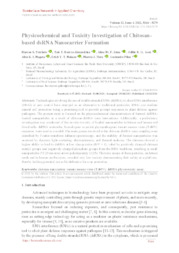Physicochemical and toxicity investigation of chitosan-based dsRNA nanocarrier formation.
Physicochemical and toxicity investigation of chitosan-based dsRNA nanocarrier formation.
Autoria: PETRÔNIO, M. S.; BARROS-ALEXANDRINO, T. T.; LIMA, A. M. F.; ASSIS, O. B. G. de; INOUE-NAGATA, A. K.; NAKASU, E. Y. T.; TIERA, M. J.; PILON, L.
Resumo: Technologies involving the use of double-stranded RNA (dsRNA) to elicit RNA interference (RNAi) in pest control have emerged as an alternative to traditional pesticides. RNAi can mediate natural cell protection being a promising tool to provide prompt responses in plant defense against pathogens. The present study is focused on the physicochemical characterization of formed dsRNAloaded nanoparticles as a result of chitosan-dsRNA ionic interactions. Additionally, a preliminary investigation was conducted of the in-vitro toxicity of loaded nanoparticles in lettuce and human red blood cells. dsRNA molecules, homologous to partial phytopathogenic tomato mosaic virus (ToMV) sequence, were used as a model. The main groups involved in the chitosan-dsRNA ionic coupling were identified by Fourier-transform infrared spectroscopy, and the stability of formed nanoparticles was accessed by dynamic light scattering, electrophoresis, and thermal analyses. The chitosan showed a higher ability to bind to dsRNA at low charge ratios (N/P = 1), ruled by positively charged chitosan methyl groups and negatively charged phosphate groups from the RNA backbone, resulting in small nanoparticles (73.25 nm size) at low polydispersity (0.25). The toxic assays of these particles, on lettuce seeds and in human erythrocytes, revealed very low toxicity demonstrating their safety as a platform, thereby holding potential use as biodefensive for crop protection.
Ano de publicação: 2022
Tipo de publicação: Artigo de periódico
Unidade: Embrapa Instrumentação
Observações
1 - Por padrão são exibidas publicações dos últimos 20 anos. Para encontrar publicações mais antigas, configure o filtro ano de publicação, colocando o ano a partir do qual você deseja encontrar publicações. O filtro está na coluna da esquerda na busca acima.
2 - Para ler algumas publicações da Embrapa (apenas as que estão em formato ePub), é necessário ter, no celular ou computador, um desses softwares gratuitos. Sistemas Android: Google Play Livros; IOS: iBooks; Windows e Linux: software Calibre.
Acesse outras publicações
Acesse a Base de Dados da Pesquisa Agropecuária (BDPA) para consultar o acervo completo das bibliotecas da Embrapa.

